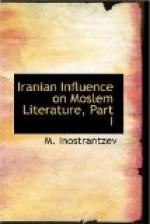[Footnote 1: This goes to confirm the hypothesis of Sir John Marshall that the curious structure with probably a fire-altar at the top excavated by him at Taxila near Rawal Pindi is a Zoroastrian atash-kadeh.]
[Sidenote: Tardy Converts.]
In the same place he makes mention of a numerous settlement of the Magians. “Here are,” he says, “a goodly number of Magians in the neighbourhood of Istakhr. There is a large stone building with carvings and pillars about which the Persians relate that it is the mosque of Solomon; the son of David, and that it is the work of genii. In bulk it is comparable to the buildings in Syria and Egypt” “In the neighborhood of Sabur is a mountain on which the representations of all the kings, governors, servitors of temples and grand mobeds who were celebrated in the times of the Persian monarchy are to be found. On the pedestals of these figures are engraved the events in connection with and the deeds of these personages.” Describing the Karen mountains Itakhri says, “The mountainous region is inaccessible and the inhabitants hold commerce with no one outside. During the Omayad period they persisted in their adherence to Zoroastrianism, and they could not be subjugated, and were worse than the inhabitants of the Koz mountain. But when the Abbasides came to power they embraced Islam. These Magians were extraordinarily brave. Yakub and Amru the sons of Leith, commenced their rule and power here and drew their supporters from these hills.” “Mokan,” says Istakhri, “contains many villages which are inhabited by the Magians.” (P. 71.)
MESOPOTAMIA AND PERSIA IN THE FOURTEENTH CENTURY.
IN THE NUZHAT AL KULUB OF HAMD-ALLAH
MUSTAWFI
BY G. Lestrange.
The following fire-temples are mentioned:—At [Transcriber’s note: word unreadable] there was an ancient fire temple called Ardahish. (P. 56)
A dragon was slain by king Kaikaushro who then built on the spot a fire temple afterwards known as Dayr Kushid. (P. 69).
Turshid was the chief city of the Kohistan province and near it was the village Kishwaz famous for the great cypress trees planted by Zoroaster as related by Firdausi in the Shah Nameh, (Turner, 1. Macar Vol. 4, line 1061). Near Tushiz were four famous castles one of which was called Arthush Gah or the Fire temple. (P. 80).
Herat was watered by the canals of the river Hari Rud. It had a famous castle called Sham Iram built over the ruins of an ancient Fire temple on a mountain two leagues distant from the city. Mustawfi adds a long account of the town, its markets and its shrines, giving the names of the various canals derived from the Hari Rud. (P. 85).
AL MUQADASI.
(BIBLIOTHECA INDICA)
[Sidenote: Zoroastrians are treated like Jews and Christians.]




